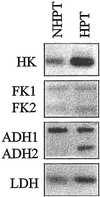Evidence for the critical role of sucrose synthase for anoxic tolerance of maize roots using a double mutant
- PMID: 9536049
- PMCID: PMC35039
- DOI: 10.1104/pp.116.4.1323
Evidence for the critical role of sucrose synthase for anoxic tolerance of maize roots using a double mutant
Abstract
The induction of the sucrose synthase (SuSy) gene (SuSy) by low O2, low temperature, and limiting carbohydrate supply suggested a role in carbohydrate metabolism under stress conditions. The isolation of a maize (Zea mays L.) line mutant for the two known SuSy genes but functionally normal showed that SuSy activity might not be required for aerobic growth and allowed the possibility of investigating its importance during anaerobic stress. As assessed by root elongation after return to air, hypoxic pretreatment improved anoxic tolerance, in correlation with the number of SuSy genes and the level of SuSy expression. Furthermore, root death in double-mutant seedlings during anoxic incubation could be attributed to the impaired utilization of sucrose (Suc). Collectively, these data provide unequivocal evidence that Suc is the principal C source and that SuSy is the main enzyme active in Suc breakdown in roots of maize seedlings deprived of O2. In this situation, SuSy plays a critical role in anoxic tolerance.
Figures






Similar articles
-
Rapid repression of maize invertases by low oxygen. Invertase/sucrose synthase balance, sugar signaling potential, and seedling survival.Plant Physiol. 1999 Oct;121(2):599-608. doi: 10.1104/pp.121.2.599. Plant Physiol. 1999. PMID: 10517852 Free PMC article.
-
Involvement of intracellular calcium in anaerobic gene expression and survival of maize seedlings.Plant Physiol. 1994 May;105(1):369-76. doi: 10.1104/pp.105.1.369. Plant Physiol. 1994. PMID: 7518090 Free PMC article.
-
Expression of sucrose synthase genes involved in enhanced elongation of pondweed (Potamogeton distinctus) turions under anoxia.Ann Bot. 2005 Sep;96(4):683-92. doi: 10.1093/aob/mci220. Epub 2005 Jul 20. Ann Bot. 2005. PMID: 16033779 Free PMC article.
-
Differential regulation of sugar-sensitive sucrose synthases by hypoxia and anoxia indicate complementary transcriptional and posttranscriptional responses.Plant Physiol. 1998 Apr;116(4):1573-83. doi: 10.1104/pp.116.4.1573. Plant Physiol. 1998. PMID: 9536076 Free PMC article.
-
An Overview of Sucrose Synthases in Plants.Front Plant Sci. 2019 Feb 8;10:95. doi: 10.3389/fpls.2019.00095. eCollection 2019. Front Plant Sci. 2019. PMID: 30800137 Free PMC article. Review.
Cited by
-
Phosphorylation of the amino terminus of maize sucrose synthase in relation to membrane association and enzyme activity.Plant Physiol. 2004 Apr;134(4):1427-38. doi: 10.1104/pp.103.036780. Plant Physiol. 2004. PMID: 15084730 Free PMC article.
-
Transcriptome analysis of barley (Hordeum vulgare L.) under waterlogging stress, and overexpression of the HvADH4 gene confers waterlogging tolerance in transgenic Arabidopsis.BMC Plant Biol. 2023 Jan 30;23(1):62. doi: 10.1186/s12870-023-04081-6. BMC Plant Biol. 2023. PMID: 36710329 Free PMC article.
-
Carbohydrate-ethanol transition in cereal grains under anoxia.New Phytol. 2001 Sep;151(3):607-612. doi: 10.1046/j.0028-646x.2001.00218.x. New Phytol. 2001. PMID: 33853250
-
Altered patterns of sucrose synthase phosphorylation and localization precede callose induction and root tip death in anoxic maize seedlings.Plant Physiol. 2001 Feb;125(2):585-94. doi: 10.1104/pp.125.2.585. Plant Physiol. 2001. PMID: 11161016 Free PMC article.
-
Molecular and cellular adaptations of maize to flooding stress.Ann Bot. 2003 Jan;91 Spec No(2):119-27. doi: 10.1093/aob/mcf210. Ann Bot. 2003. PMID: 12509333 Free PMC article. Review.
References
-
- Bradford M. A rapid and sensitive method for the quantitation of microgram quantities of protein utilizing the principle of protein dye binding. Anal Biochem. 1976;72:248–254. - PubMed
-
- Chourey PS. Genetic control of sucrose synthetase in maize endosperm. Mol Gen Genet. 1981;184:372–376.
-
- Chourey PS. Recombinants lacking in detectable levels of both sucrose synthases are functionally normal. Maize Genet Coop Newslett. 1988;62:62–63.
LinkOut - more resources
Full Text Sources
Research Materials

